Prediction and Numerical Study of Thermal Performance of Gradient Porous Structures Based on Voronoi Tessellation Design
Abstract
1. Introduction
2. Materials and Methods
2.1. Design of the Porous Structure
- is the Voronoi polyhedral space cell corresponding to the seed point ;
- is the Euclidean distance between the location point O and the seed point ;
- is a series of seed points defined in Euclidean space.
2.2. Finite Element Simulation of Heat Transfer
2.2.1. Governing Equations and Boundary Conditions
2.2.2. Mesh Independence Tests
2.2.3. Prediction Calculation
3. Results
3.1. Verification of the Accuracy of the Simulation Results
3.2. Effect of the Gradient Structure on the Effective Thermal Conductivity
3.3. Effect of the Gradient Direction on the Effective Thermal Conductivity
3.4. Heat Flux Density Distribution
3.5. Prediction of Effective Thermal Conductivity of Porous Structures
4. Discussion
5. Conclusions
- The effective thermal conductivity of the three-dimensional Voronoi gradient random porous structure is smaller than that of the regular structure without a gradient for the same porosity. With the increase in porosity, the effective thermal conductivity of both structures decreases gradually. Therefore, the introduction of the gradient structure can effectively improve the thermal protection performance of the porous structure.
- The effective thermal conductivity of the three-dimensional Voronoi gradient random porous structure is influenced by the orientation. In the case of the GV4 structure, for example, the difference in orientation leads to a maximum error of 9.68% in the effective thermal conductivity of the structure. Meanwhile, the errors in the effective thermal conductivity due to the different orientations of the three gradient structures almost all exceed 5%. Therefore, there is anisotropy in the thermal conductivity of the three-dimensional Voronoi gradient random structure.
- The heat flux density represents the ability to transfer heat in a structure. The heat flux density distribution of the regular structure is more uniform than that of the three-dimensional Voronoi gradient random porous structure. This is because regular structures have fewer heat transfer paths. In contrast, the heat transfer path in the three-dimensional Voronoi gradient random porous structure is more complex and tortuous, increasing the thermal resistance and weakening the thermal conductivity of the material.
- Based on the Grasshopper platform, a battery pack set was designed for calculating the effective thermal conductivity of pillar-based porous materials, including three-dimensional Voronoi gradient random porous materials, which allows for a more accurate prediction of the effective thermal conductivity of a pillar-based porous material. The predicted calculation results and the simulation results basically agree with each other, and the relative errors of both are within 10%. The cell set verifies the accuracy of the simulation results to a certain extent, and it also provides some reference for application to the design of thermal protection structures.
Author Contributions
Funding
Institutional Review Board Statement
Informed Consent Statement
Data Availability Statement
Conflicts of Interest
References
- Cheng, Z.; Xu, R.; Jiang, P.X. Morphology, flow and heat transfer in triply periodic minimal surface based porous structures. Int. J. Heat Mass Transf. 2021, 170, 120902. [Google Scholar] [CrossRef]
- Zheng, T.; Zhou, W.; Chu, X.; Lian, Y.; Huang, X.; San Hui, K.; Hui, K.N. A columnar regular-porous stainless steel reaction support with high superficial area for hydrogen production. Int. J. Hydrogen Energy 2022, 47, 10204–10216. [Google Scholar] [CrossRef]
- Lin, K.; Hu, K.; Gu, D. Metallic integrated thermal protection structures inspired by the Norway spruce stem: Design, numerical simulation and selective laser melting fabrication. Opt. Laser Technol. 2019, 115, 9–19. [Google Scholar] [CrossRef]
- Zhao, H.; Han, Y.; Pan, C.; Yang, D.; Wang, H.; Wang, T.; Zeng, X.; Su, P. Design and Mechanical Properties Verification of Gradient Voronoi Scaffold for Bone Tissue Engineering. Micromachines 2021, 12, 664. [Google Scholar] [CrossRef]
- Ghahremannezhad, A.; Xu, H.; Salimpour, M.R.; Wang, P.; Vafai, K. Thermal performance analysis of phase change materials (PCMs) embedded in gradient porous metal foams. Appl. Therm. Eng. 2020, 179, 115731. [Google Scholar] [CrossRef]
- Mo, D.C.; Yang, S.; Luo, J.L.; Wang, Y.Q.; Lyu, S.S. Enhanced pool boiling performance of a porous honeycomb copper surface with radial diameter gradient. Int. J. Heat Mass Transf. 2020, 157, 119867. [Google Scholar] [CrossRef]
- Muzaki, F.; Limanza, J.; Surname, G.N. Numerical Simulation and Analysis of Functionally Graded Materials and It’s Potentials for Battery Application: A Review. In Proceedings of the 2021 3rd International Symposium on Material and Electrical Engineering Conference (ISMEE), Vitural, 10–11 November 2021; pp. 249–252. [Google Scholar]
- Zheng, X.; Sun, T.; Zhou, J.; Zhang, R.; Ming, P. Modeling of Polycrystalline Material Microstructure with 3D Grain Boundary Based on Laguerre–Voronoi Tessellation. Materials 2022, 15, 1996. [Google Scholar] [CrossRef]
- Chen, Z.; Zhang, T.; Cao, J.; Zhang, Y.J.; Wang, C. Point cloud resampling using centroidal Voronoi tessellation methods. Comput. Aided Des. 2018, 102, 12–21. [Google Scholar] [CrossRef]
- Wang, G.; Shen, L.; Zhao, J.; Liang, H.; Xie, D.; Tian, Z.; Wang, C. Design and compressive behavior of controllable irregular porous scaffolds: Based on voronoi-tessellation and for additive manufacturing. ACS Biomater. Sci. Eng. 2018, 4, 719–727. [Google Scholar] [CrossRef]
- Baillis, D.; Coquard, R.; Cunsolo, S. Effective conductivity of Voronoi’s closed-and open-cell foams: Analytical laws and numerical results. J. Mater. Sci. 2017, 52, 11146–11167. [Google Scholar] [CrossRef]
- Siegkas, P. A Computational Geometry Generation Method for Creating 3D Printed Composites and Porous Structures. Materials 2021, 14, 2507. [Google Scholar] [CrossRef] [PubMed]
- Lei, H.Y.; Li, J.R.; Xu, Z.J.; Wang, Q.H. Parametric design of Voronoi-based lattice porous structures. Mater. Des. 2020, 191, 108607. [Google Scholar] [CrossRef]
- Zhang, M.; Shang, J.; Guo, S.; Hur, B.; Yue, X. Numerical investigation of effective thermal conductivity of strut-based cellular structures designed by spatial Voronoi tessellation. Materials 2020, 14, 138. [Google Scholar] [CrossRef]
- Li, Y.; Xia, X.L.; Sun, C.; Ai, Q.; Tan, H.P. Radiative characteristics of Voronoi open-cell foams made from semitransparent media. Int. J. Heat Mass Transf. 2019, 133, 1008–1018. [Google Scholar] [CrossRef]
- Du, Y.; Liang, H.; Xie, D.; Mao, N.; Zhao, J.; Tian, Z.; Wang, C.; Shen, L. Design and statistical analysis of irregular porous scaffolds for orthopedic reconstruction based on voronoi tessellation and fabricated via selective laser melting (SLM). Mater. Chem. Phys. 2020, 239, 121968. [Google Scholar] [CrossRef]
- Fantini, M.; Curto, M. Interactive design and manufacturing of a Voronoi-based biomimetic bone scaffold for morphological characterization. Int. J. Interact. Des. Manuf. 2018, 12, 585–596. [Google Scholar] [CrossRef]
- Peng, Y.; Yang, X.; Li, Z.; Li, S.; Cao, B. Numerical simulation of cooling performance of heat sink designed based on symmetric and asymmetric leaf veins. Int. J. Heat Mass Transf. 2021, 166, 120721. [Google Scholar] [CrossRef]
- Ghouse, S.; Oosterbeek, R.N.; Mehmood, A.T.; Vecchiato, F.; Dye, D.; Jeffers, J.R. Vacuum heat treatments of titanium porous structures. Addit. Manuf. 2021, 47, 102262. [Google Scholar] [CrossRef]
- Wu, M.H.; Lee, M.H.; Wu, C.; Tsai, P.I.; Hsu, W.B.; Huang, S.I.; Lin, T.H.; Yang, K.Y.; Chen, C.Y.; Chen, S.H.; et al. In Vitro and In Vivo Comparison of Bone Growth Characteristics in Additive-Manufactured Porous Titanium, Nonporous Titanium, and Porous Tantalum Interbody Cages. Materials 2022, 15, 3670. [Google Scholar] [CrossRef]
- Gardan, J. Additive manufacturing technologies: State of the art and trends. Addit. Manuf. Handb. 2017, 54, 149–168. [Google Scholar] [CrossRef]
- Ahmadi, S.M.; Amin Yavari, S.; Wauthle, R.; Pouran, B.; Schrooten, J.; Weinans, H.; Zadpoor, A.A. Additively manufactured open-cell porous biomaterials made from six different space-filling unit cells: The mechanical and morphological properties. Materials 2015, 8, 1871–1896. [Google Scholar] [CrossRef] [PubMed]
- Gu, D.D.; Meiners, W.; Wissenbach, K.; Poprawe, R. Laser additive manufacturing of metallic components: Materials, processes and mechanisms. Int. Mater. Rev. 2012, 57, 133–164. [Google Scholar] [CrossRef]
- Sidambe, A.T. Biocompatibility of advanced manufactured titanium implants—A review. Materials 2014, 7, 8168–8188. [Google Scholar] [CrossRef] [PubMed]
- Blakey-Milner, B.; Gradl, P.; Snedden, G.; Brooks, M.; Pitot, J.; Lopez, E.; Leary, M.; Berto, F.; du Plessis, A. Metal additive manufacturing in aerospace: A review. Mater. Des. 2021, 209, 110008. [Google Scholar] [CrossRef]
- Nakajima, H. Fabrication, properties and application of porous metals with directional pores. Prog. Mater. Sci. 2007, 52, 1091–1173. [Google Scholar] [CrossRef]
- Maconachie, T.; Leary, M.; Lozanovski, B.; Zhang, X.; Qian, M.; Faruque, O.; Brandt, M. SLM lattice structures: Properties, performance, applications and challenges. Mater. Des. 2019, 183, 108137. [Google Scholar] [CrossRef]
- Hao, Y.L.; Li, S.J.; Yang, R. Biomedical titanium alloys and their additive manufacturing. Rare Met. 2016, 35, 661–671. [Google Scholar] [CrossRef]
- Geetha, M.; Singh, A.K.; Asokamani, R.; Gogia, A.K. Ti based biomaterials, the ultimate choice for orthopaedic implants—A review. Prog. Mater. Sci. 2009, 54, 397–425. [Google Scholar] [CrossRef]
- Imran, R.; Al Rashid, A.; Koç, M. Review on computational modeling for the property, process, product and performance (PPPP) characteristics of additively manufactured porous magnesium implants. Bioprinting 2022, 28, e00236. [Google Scholar] [CrossRef]
- Zhang, J.; Rajkhowa, R.; Li, J.; Liu, X.; Wang, X. Silkworm cocoon as natural material and structure for thermal insulation. Mater. Des. 2013, 49, 842–849. [Google Scholar] [CrossRef]
- Du, N.; Fan, J.; Wu, H.; Chen, S.; Liu, Y. An improved model of heat transfer through penguin feathers and down. J. Theor. Biol. 2007, 248, 727–735. [Google Scholar] [CrossRef]
- Almonti, D.; Baiocco, G.; Mingione, E.; Ucciardello, N. Evaluation of the effects of the metal foams geometrical features on thermal and fluid-dynamical behavior in forced convection. Int. J. Adv. Manuf. Technol. 2020, 111, 1157–1172. [Google Scholar] [CrossRef]
- Xu, Y.; Zhang, D.; Zhou, Y.; Wang, W.; Cao, X. Study on topology optimization design, manufacturability, and performance evaluation of Ti-6Al-4V porous structures fabricated by selective laser melting (SLM). Materials 2017, 10, 1048. [Google Scholar] [CrossRef]
- Zhu, L.; Liang, H.; Lv, F.; Xie, D.; Wang, C.; Mao, Y.; Yang, Y.; Tian, Z.; Shen, L. Design and compressive fatigue properties of irregular porous scaffolds for orthopedics fabricated using selective laser melting. ACS Biomater. Sci. Eng. 2021, 7, 1663–1672. [Google Scholar] [CrossRef]
- Peixinho, N.; Carvalho, O.; Areias, C.; Pinto, P.; Silva, F. Compressive properties and energy absorption of metal-polymer hybrid cellular structures. Mater. Sci. Eng. A 2020, 794, 139921. [Google Scholar] [CrossRef]
- Yang, L.; Han, C.; Wu, H.; Hao, L.; Wei, Q.; Yan, C.; Shi, Y. Insights into unit cell size effect on mechanical responses and energy absorption capability of titanium graded porous structures manufactured by laser powder bed fusion. J. Mech. Behav. Biomed. Mater. 2020, 109, 103843. [Google Scholar] [CrossRef]
- Basheer, A.A. Advances in the smart materials applications in the aerospace industries. Aircr. Eng. Aerosp. Technol. 2020, 92, 1027–1035. [Google Scholar] [CrossRef]
- Ali, I.; Burakov, A.E.; Melezhik, A.V.; Babkin, A.V.; Burakova, I.V.; Neskomornaya, M.E.A.; Galunin, E.V.; Tkachev, A.G.; Kuznetsov, D.V. Removal of copper (II) and zinc (II) ions in water on a newly synthesized polyhydroquinone/graphene nanocomposite material: Kinetics, thermodynamics and mechanism. ChemistrySelect 2019, 4, 12708–12718. [Google Scholar] [CrossRef]
- Ali, I.; Kucherova, A.; Memetov, N.; Pasko, T.; Ovchinnikov, K.; Pershin, V.; Kuznetsov, D.; Galunin, E.; Grachev, V.; Tkachev, A.; et al. Advances in carbon nanomaterials as lubricants modifiers. J. Mol. Liq. 2019, 279, 251–266. [Google Scholar] [CrossRef]
- Ali, I.; Alharbi, O.M.; Alothman, Z.A.; Badjah, A.Y.; Alwarthan, A. Artificial neural network modelling of amido black dye sorption on iron composite nano material: Kinetics and thermodynamics studies. J. Mol. Liq. 2018, 250, 1–8. [Google Scholar] [CrossRef]
- Ali, I.; Kuznetsova, T.S.; Burakov, A.E.; Burakova, I.V.; Pasko, T.V.; Dyachkova, T.P.; Mkrtchyan, E.S.; Babkin, A.V.; Tkachev, A.G.; Albishri, H.M.; et al. Polyaniline Modified CNTs and Graphene Nanocomposite for Removal of Lead and Zinc Metal Ions: Kinetics, Thermodynamics and Desorption Studies. Molecules 2022, 27, 5623. [Google Scholar] [CrossRef] [PubMed]
- Zhou, L.; Ju, Y.; Pei, Y.; Fang, D. Dual-band and thermo-mechanical design method for radome walls with graded porous structure. J. ElEctromagnEtic WavEs Appl. 2016, 30, 1391–1406. [Google Scholar] [CrossRef]
- Almonti, D.; Baiocco, G.; Tagliaferri, V.; Ucciardello, N. Design and mechanical characterization of Voronoi structures manufactured by indirect additive manufacturing. Materials 2020, 13, 1085. [Google Scholar] [CrossRef] [PubMed]
- Liu, Y.; Zhang, J.; Tan, Q.; Yin, Y.; Li, M.; Zhang, M.X. Mechanical performance of simple cubic architected titanium alloys fabricated via selective laser melting. Opt. Laser Technol. 2021, 134, 106649. [Google Scholar] [CrossRef]
- Li, S.; Xu, Q.; Wang, Z.; Hou, W.; Hao, Y.; Yang, R.; Murr, L. Influence of cell shape on mechanical properties of Ti–6Al–4V meshes fabricated by electron beam melting method. Acta Biomater. 2014, 10, 4537–4547. [Google Scholar] [CrossRef]
- Sadeghi, E.; Hsieh, S.; Bahrami, M. Thermal conductivity and contact resistance of metal foams. J. Phys. D Appl. Phys. 2011, 44, 125406. [Google Scholar] [CrossRef]
- Boomsma, K.; Poulikakos, D. On the effective thermal conductivity of a three-dimensionally structured fluid-saturated metal foam. Int. J. Heat Mass Transf. 2001, 44, 827–836. [Google Scholar] [CrossRef]
- Paek, J.; Kang, B.; Kim, S.; Hyun, J.M. Effective thermal conductivity and permeability of aluminum foam materials. Int. J. Thermophys. 2000, 21, 453–464. [Google Scholar] [CrossRef]
- Phanikumar, M.; Mahajan, R. Non-Darcy natural convection in high porosity metal foams. Int. J. Heat Mass Transf. 2002, 45, 3781–3793. [Google Scholar] [CrossRef]

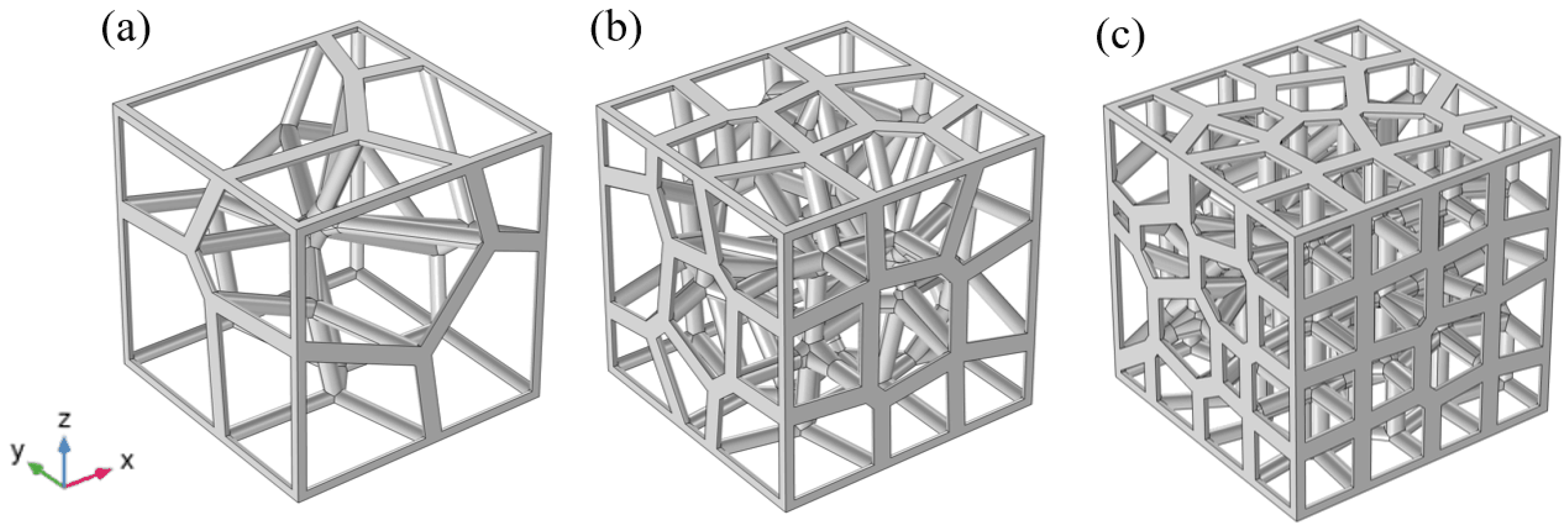

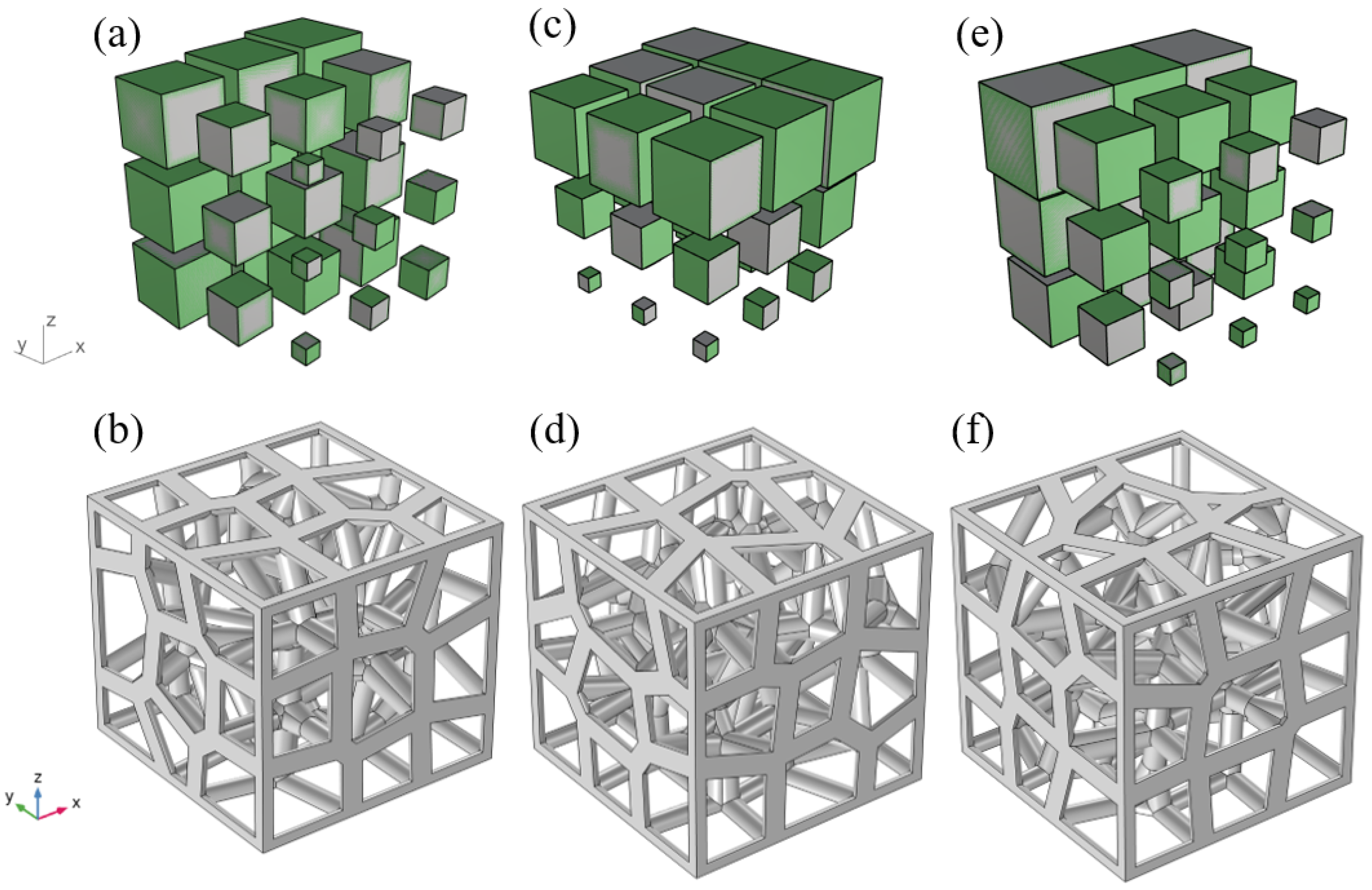

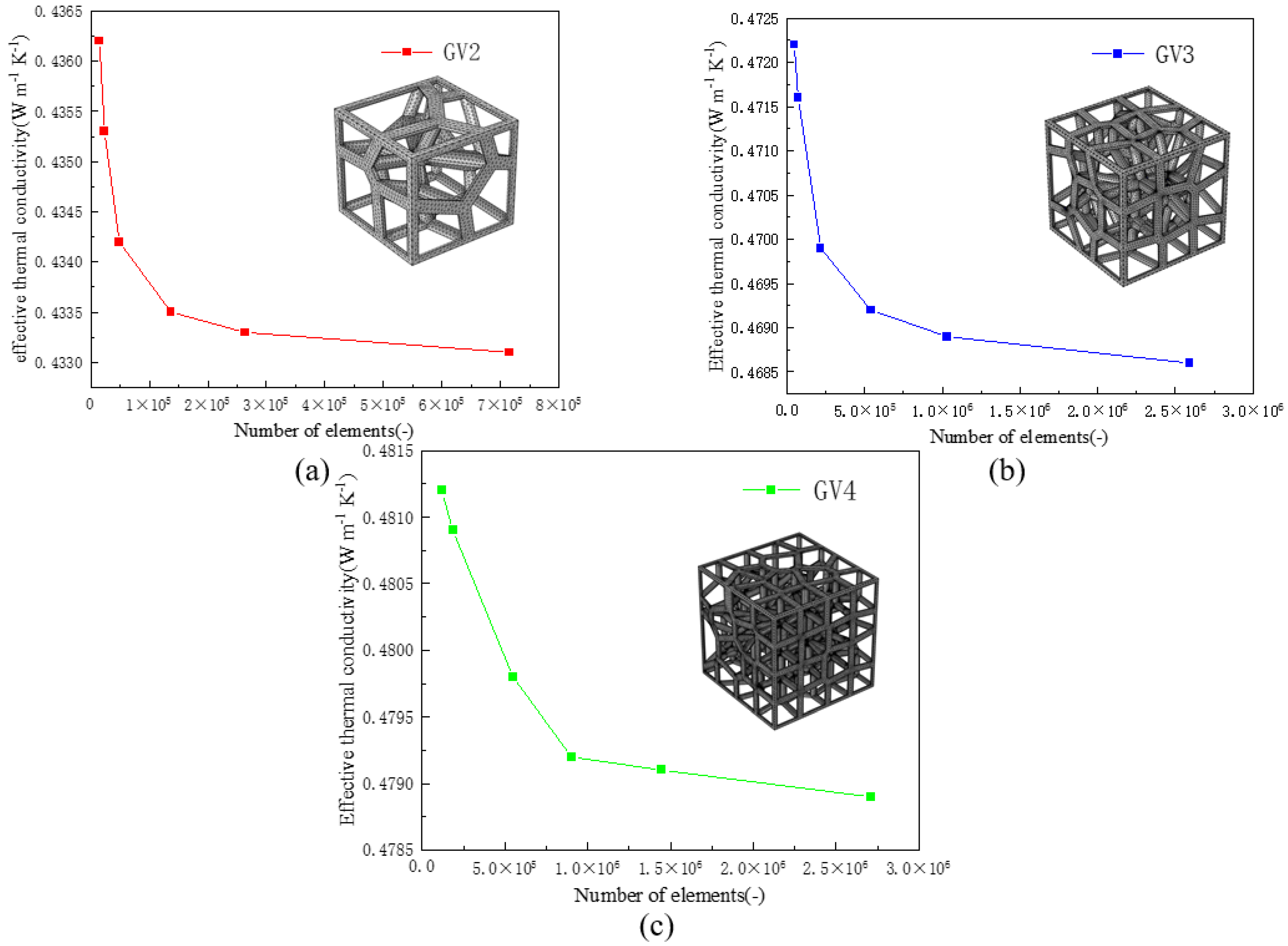
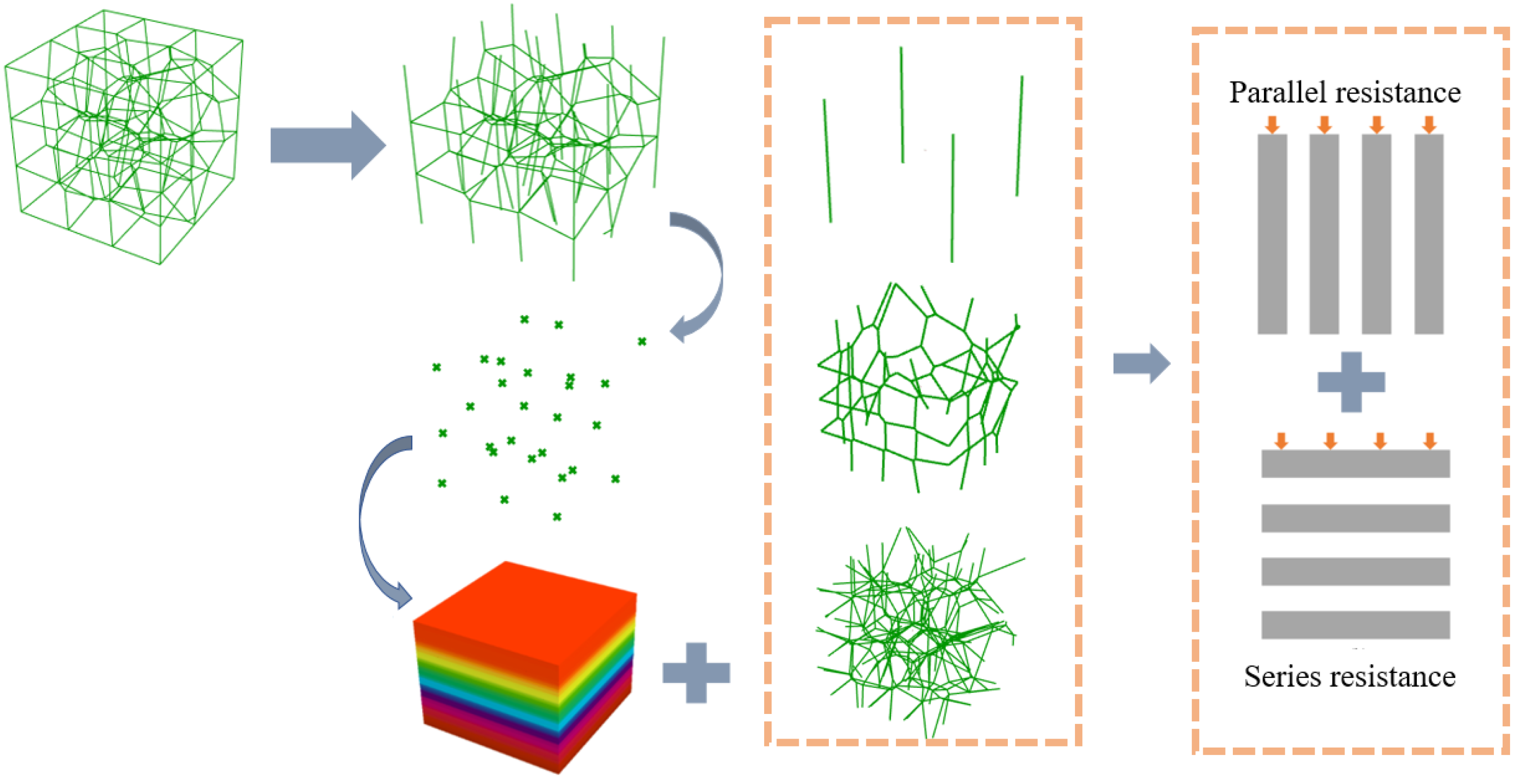
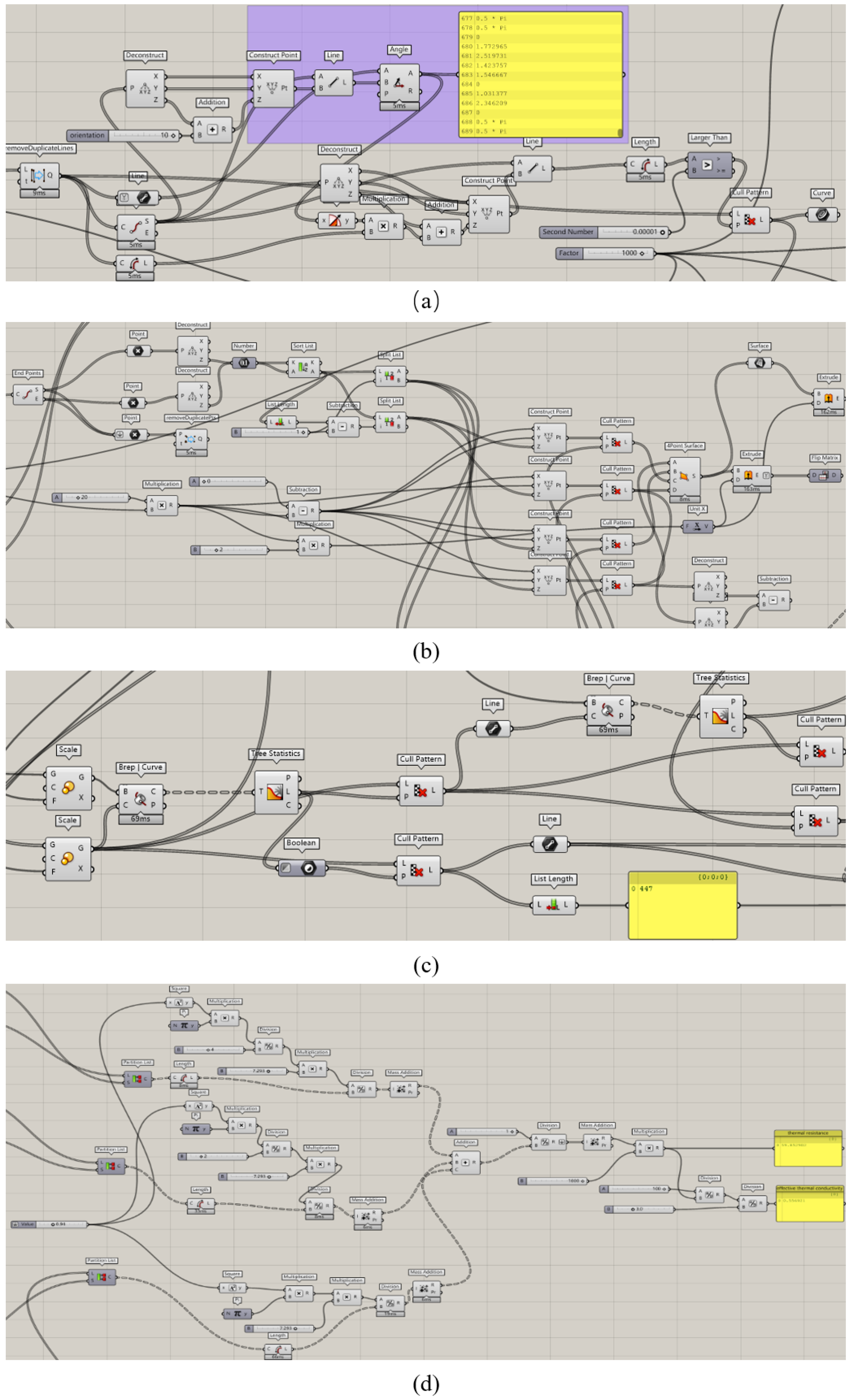


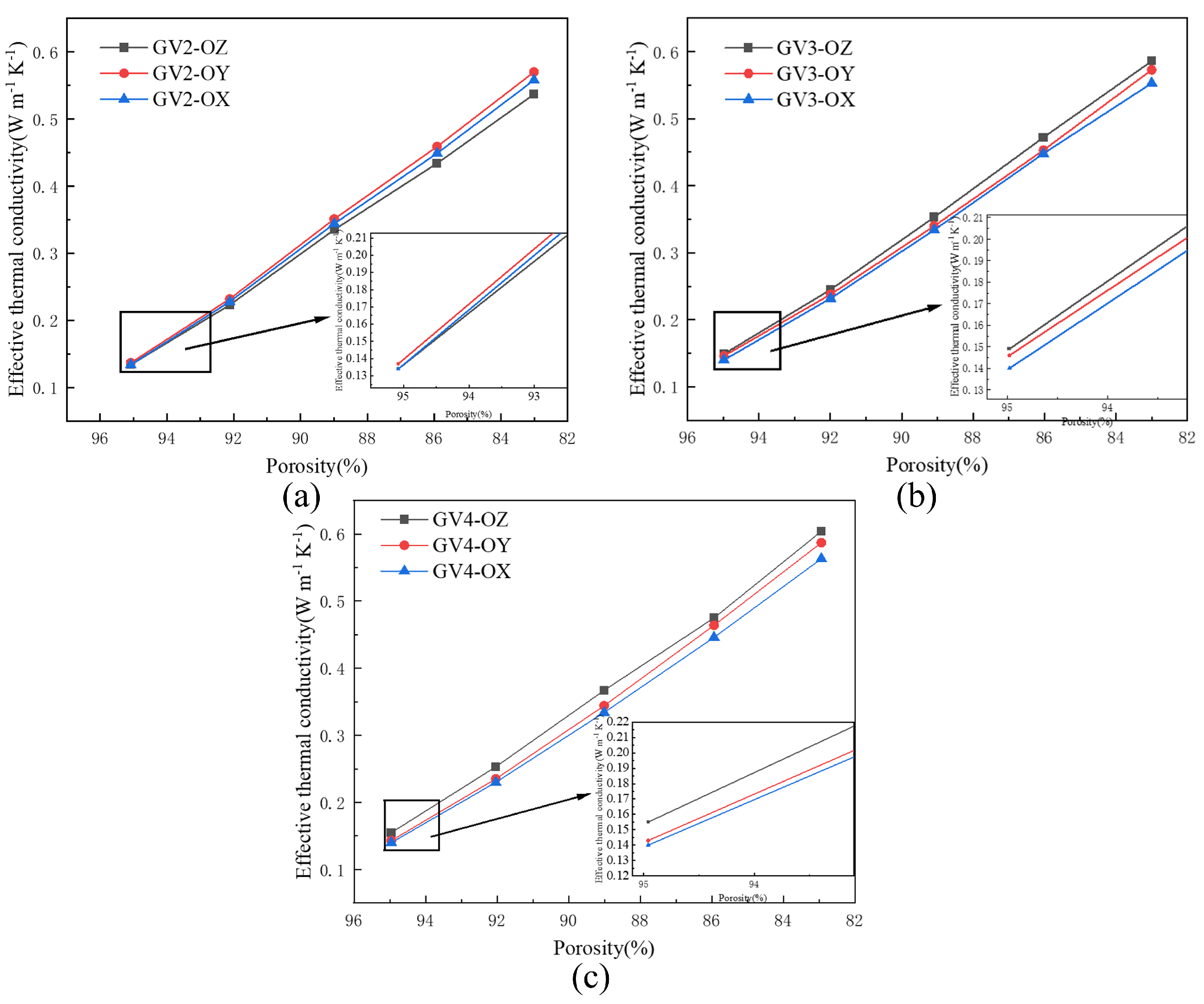
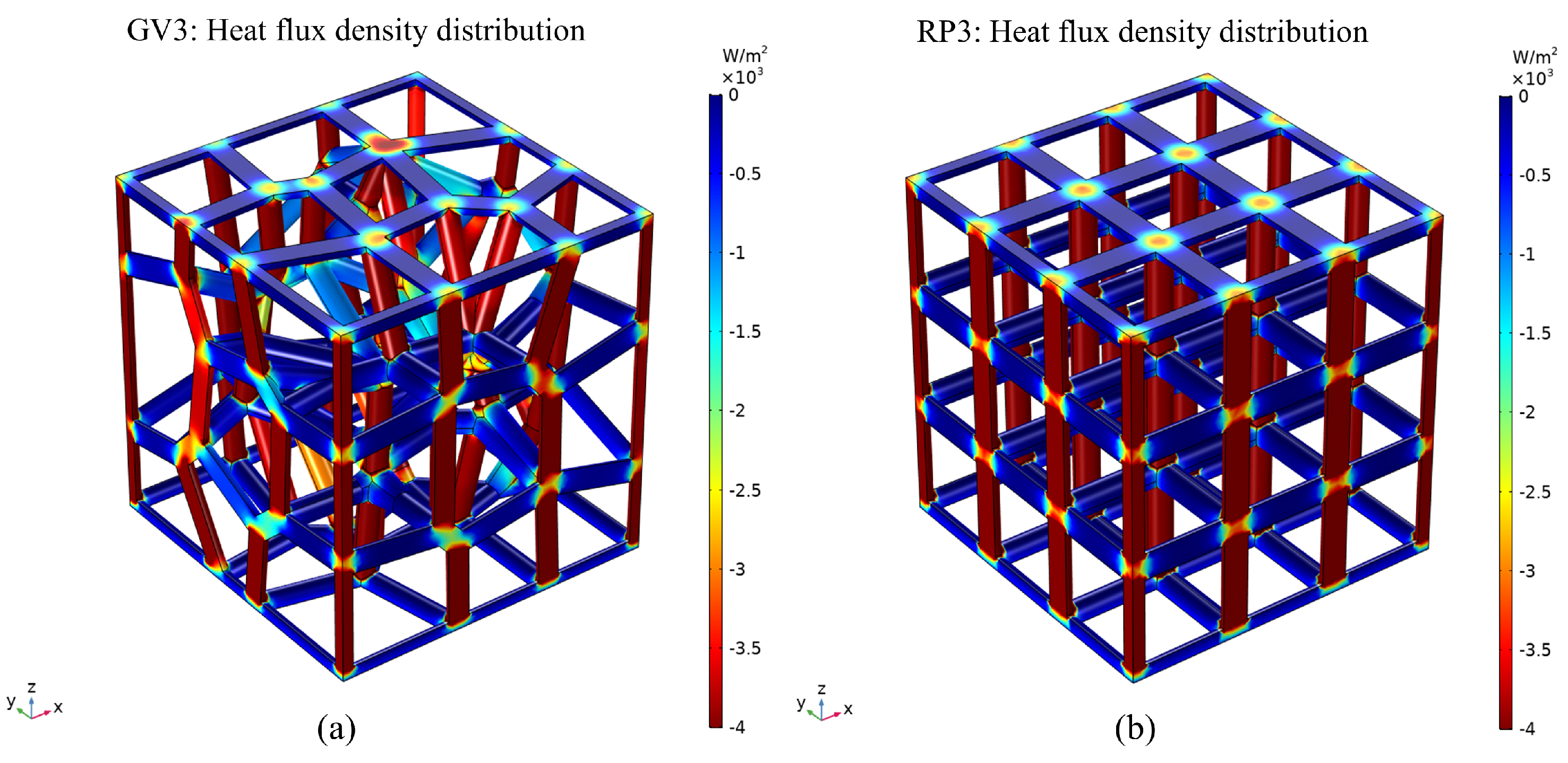
| Model | Research Method | Innovation Points | Application | Cite |
|---|---|---|---|---|
| Voronoi structure | Finite element analysis | The Voronoi structures were generated by adjusting the number of seed points | Thermal conduction | [14] |
| Voronoi structure | Theoretical calculation | The Voronoi structures were generated by adjusting the foam porosity and pores per inch parameters | Radiative characteristics | [15] |
| Voronoi structure | Experiment | The Voronoi structures were generated by adjusting the three structural design parameters (strut diameter D, unit distance d, irregularity i) | Mechanical | [16] |
| Voronoi structure | Experiment | The Voronoi structures were generated by adjusting the three structural design parameters (pores per inch (PPI), branch thickness (r), and edges morphology (smooth-regular)) | Convective heat transfer | [33] |
| Voronoi structure | Finite element analysis | The Voronoi structures were generated by adjusting the spatial gradient range of random points | Thermal conduction | - |
| Structures | Porosity (%) | Strut Radius (mm) | Volume of the Cellular Structures (mm) | Surface Area (mm) |
|---|---|---|---|---|
| 95.08 | 1.02 | 1327.90 | 3820.10 | |
| 92.12 | 1.31 | 2125.00 | 4721.90 | |
| GV2 | 88.99 | 1.59 | 2972.70 | 5512.80 |
| 85.91 | 1.80 | 3803.70 | 6055.00 | |
| 83.01 | 1.99 | 4587.30 | 6507.70 | |
| 94.98 | 0.66 | 1355.40 | 5215.60 | |
| 91.99 | 0.84 | 2162.30 | 6298.40 | |
| GV3 | 89.09 | 1.00 | 2953.40 | 7147.00 |
| 86.03 | 1.15 | 3771.40 | 7849.40 | |
| 83.00 | 1.29 | 4591.00 | 8432.40 | |
| 94.96 | 0.48 | 1360.80 | 6610.50 | |
| 92.04 | 0.61 | 2147.90 | 7973.50 | |
| GV4 | 89.01 | 0.73 | 2967.80 | 9055.50 |
| 85.94 | 0.84 | 3797.00 | 9909.80 | |
| 82.94 | 0.94 | 4696.30 | 10,620.00 | |
| 94.95 | 1.17 | 1363.50 | 3827.70 | |
| 91.91 | 1.50 | 2184.30 | 4725.50 | |
| RP2 | 88.96 | 1.78 | 2980.80 | 5376.60 |
| 86.10 | 1.98 | 3753.00 | 5888.70 | |
| 82.97 | 2.28 | 4598.10 | 6529.70 | |
| 94.98 | 0.78 | 1355.40 | 5019.20 | |
| 91.92 | 1.00 | 2181.60 | 6115.90 | |
| RP3 | 88.92 | 1.17 | 2991.20 | 6930.90 |
| 86.00 | 1.33 | 3780.20 | 7638.20 | |
| 83.04 | 1.48 | 4579.80 | 8248.10 | |
| 94.96 | 0.58 | 1360.80 | 6074.70 | |
| 91.99 | 0.77 | 2162.70 | 7699.10 | |
| RP4 | 88.94 | 0.85 | 2985.50 | 8252.10 |
| 85.94 | 1.00 | 3795.20 | 9370.20 | |
| 82.92 | 1.12 | 4611.60 | 10,152.00 |
| Temperature (K) | Density (kg/m) | Thermal Conductivity (WmK) | Specific Heat (J/(kg K)) |
|---|---|---|---|
| 293.15 | 4429.989 | 7.076 | 536.041 |
| 313.15 | 4428.525 | 7.147 | 545.973 |
| 333.15 | 4425.977 | 7.285 | 553.497 |
| 353.15 | 4423.419 | 7.441 | 560.723 |
| 373.15 | 4420.850 | 7.613 | 567.660 |
| 393.15 | 4418.271 | 7.800 | 574.316 |
| Structure | Very Rough | Rough | General | Fine | Hyperfine | Finest |
|---|---|---|---|---|---|---|
| GV2 | 14,944 | 23,535 | 48,666 | 137,164 | 263,210 | 714,978 |
| GV3 | 46,080 | 71,778 | 216,828 | 538,697 | 1,030,911 | 2,590,053 |
| GV4 | 117,376 | 184,728 | 547,497 | 900,518 | 1,447,680 | 2,707,665 |
| Structure | Porosity (%) | Effective Thermal Conductivity (WmK) | ||
|---|---|---|---|---|
| OZ | OY | OX | ||
| 95.08 | 0.134 | 0.137 | 0.134 | |
| 92.12 | 0.223 | 0.232 | 0.228 | |
| GV2 | 88.99 | 0.335 | 0.351 | 0.344 |
| 85.91 | 0.434 | 0.459 | 0.449 | |
| 83.01 | 0.537 | 0.570 | 0.558 | |
| 94.98 | 0.149 | 0.146 | 0.140 | |
| 91.99 | 0.245 | 0.238 | 0.232 | |
| GV3 | 89.06 | 0.353 | 0.340 | 0.334 |
| 86.03 | 0.472 | 0.453 | 0.448 | |
| 83.00 | 0.586 | 0.573 | 0.553 | |
| 94.96 | 0.155 | 0.143 | 0.140 | |
| 92.04 | 0.253 | 0.235 | 0.230 | |
| GV4 | 89.01 | 0.367 | 0.344 | 0.334 |
| 85.94 | 0.475 | 0.464 | 0.446 | |
| 82.94 | 0.604 | 0.587 | 0.563 | |
| 94.95 | 0.139 | |||
| 91.91 | 0.235 | |||
| RP2 | 88.96 | 0.341 | ||
| 86.10 | 0.452 | |||
| 82.97 | 0.565 | |||
| 94.98 | 0.153 | |||
| 91.92 | 0.259 | |||
| RP3 | 88.92 | 0.359 | ||
| 86.00 | 0.474 | |||
| 83.04 | 0.597 | |||
| 94.96 | 0.159 | |||
| 91.99 | 0.278 | |||
| RP4 | 88.94 | 0.370 | ||
| 85.94 | 0.479 | |||
| 82.92 | 0.610 | |||
| Porosity (%) | 94.85 | 91.99 | 89.06 | 86.03 | 83.00 |
| Effective Thermal conductivity (WmK) | 4.46 | 7.26 | 10.26 | 13.88 | 17.42 |
| Structure | Porosity (%) | Predicted Results (WmK) | Relative Error (%) |
|---|---|---|---|
| 95.08 | 0.134 | −0.00 | |
| 92.12 | 0.221 | −0.90 | |
| GV2 | 88.99 | 0.326 | −2.98 |
| 85.91 | 0.418 | −4.57 | |
| 83.01 | 0.511 | −6.07 | |
| 94.98 | 0.143 | −0.67 | |
| 91.99 | 0.232 | −1.22 | |
| GV3 | 89.09 | 0.329 | −3.12 |
| 86.03 | 0.434 | −4.03 | |
| 83.00 | 0.547 | −6.66 | |
| 94.96 | 0.145 | −5.81 | |
| 92.04 | 0.234 | −6.00 | |
| GV4 | 89.01 | 0.336 | −7.63 |
| 85.94 | 0.445 | −8.42 | |
| 82.94 | 0.557 | −8.77 |
Publisher’s Note: MDPI stays neutral with regard to jurisdictional claims in published maps and institutional affiliations. |
© 2022 by the authors. Licensee MDPI, Basel, Switzerland. This article is an open access article distributed under the terms and conditions of the Creative Commons Attribution (CC BY) license (https://creativecommons.org/licenses/by/4.0/).
Share and Cite
Zhang, X.; Zhang, M.; Zhang, C.; Zhou, T.; Wu, X.; Yue, X. Prediction and Numerical Study of Thermal Performance of Gradient Porous Structures Based on Voronoi Tessellation Design. Materials 2022, 15, 8046. https://doi.org/10.3390/ma15228046
Zhang X, Zhang M, Zhang C, Zhou T, Wu X, Yue X. Prediction and Numerical Study of Thermal Performance of Gradient Porous Structures Based on Voronoi Tessellation Design. Materials. 2022; 15(22):8046. https://doi.org/10.3390/ma15228046
Chicago/Turabian StyleZhang, Xiang, Minghao Zhang, Chenping Zhang, Tian Zhou, Xuncheng Wu, and Xuezheng Yue. 2022. "Prediction and Numerical Study of Thermal Performance of Gradient Porous Structures Based on Voronoi Tessellation Design" Materials 15, no. 22: 8046. https://doi.org/10.3390/ma15228046
APA StyleZhang, X., Zhang, M., Zhang, C., Zhou, T., Wu, X., & Yue, X. (2022). Prediction and Numerical Study of Thermal Performance of Gradient Porous Structures Based on Voronoi Tessellation Design. Materials, 15(22), 8046. https://doi.org/10.3390/ma15228046








